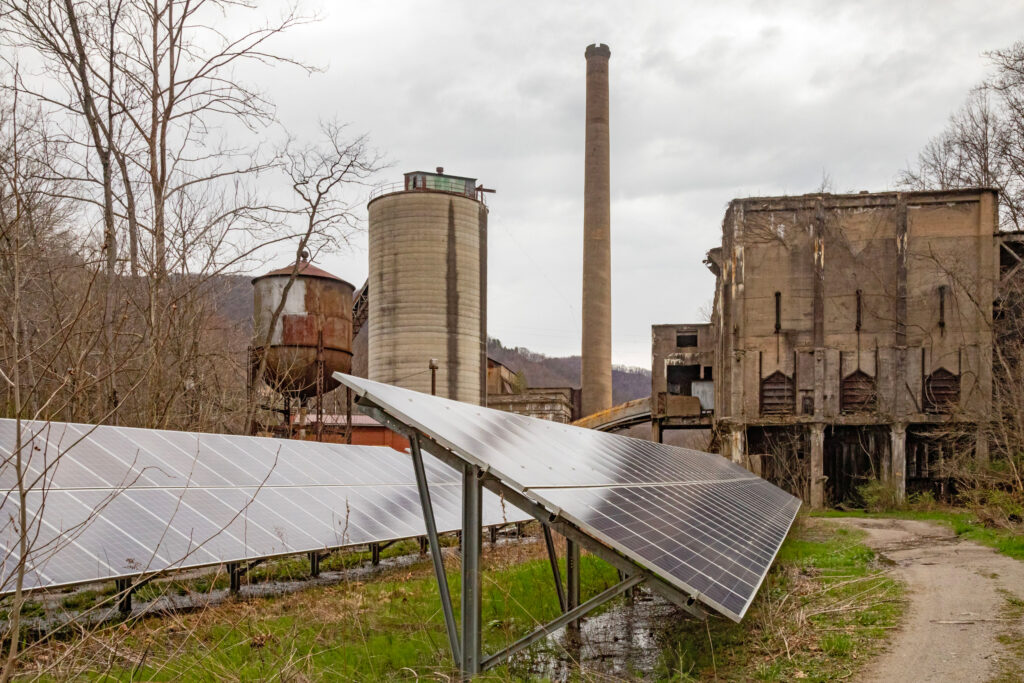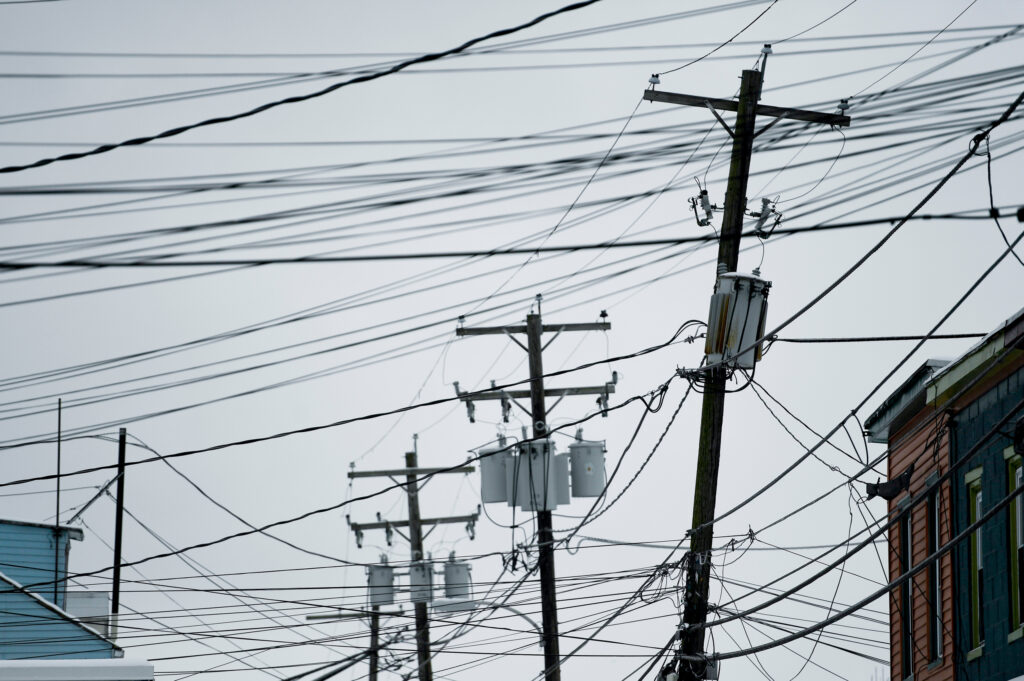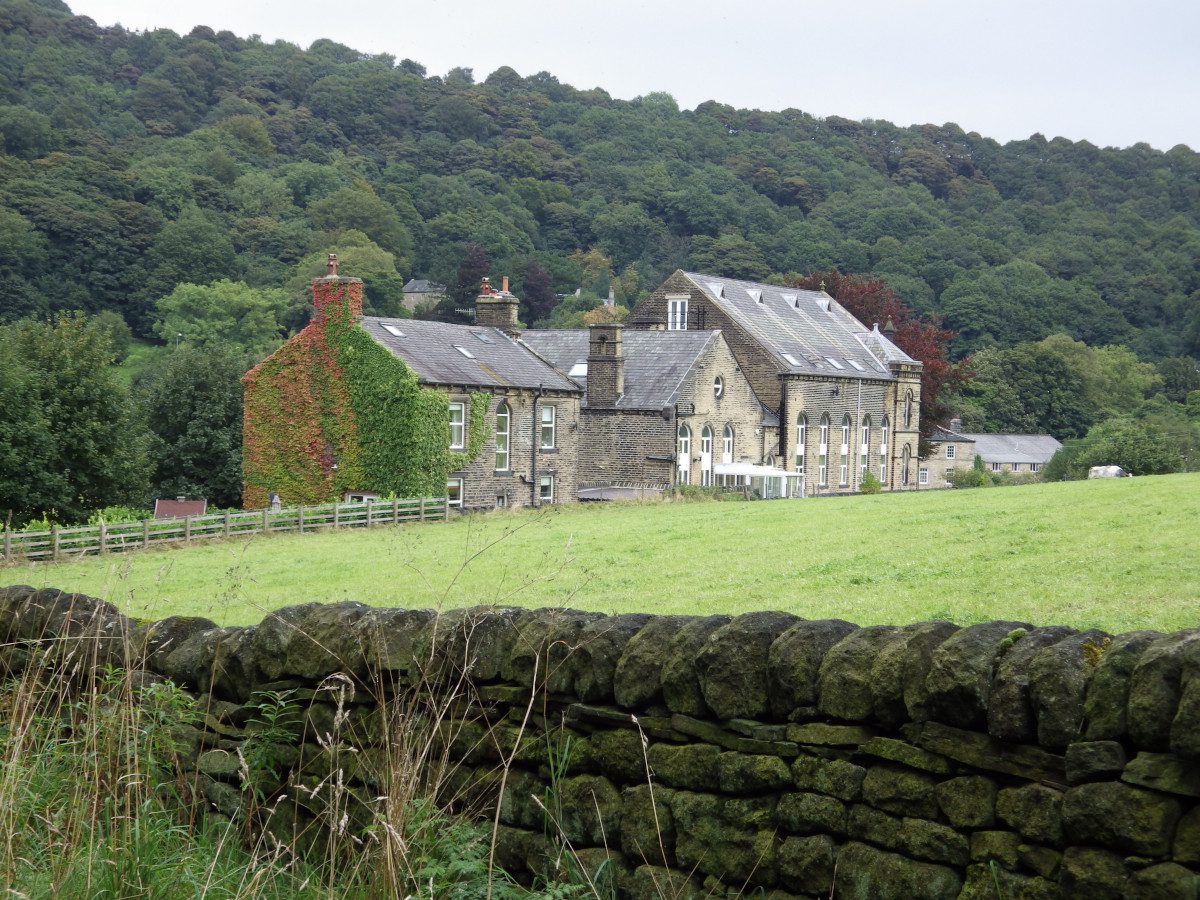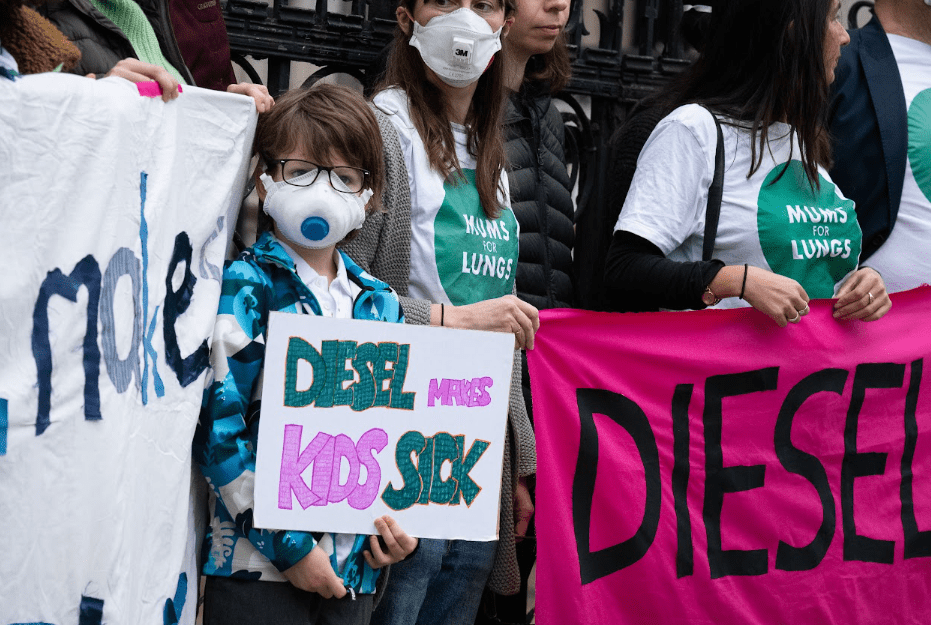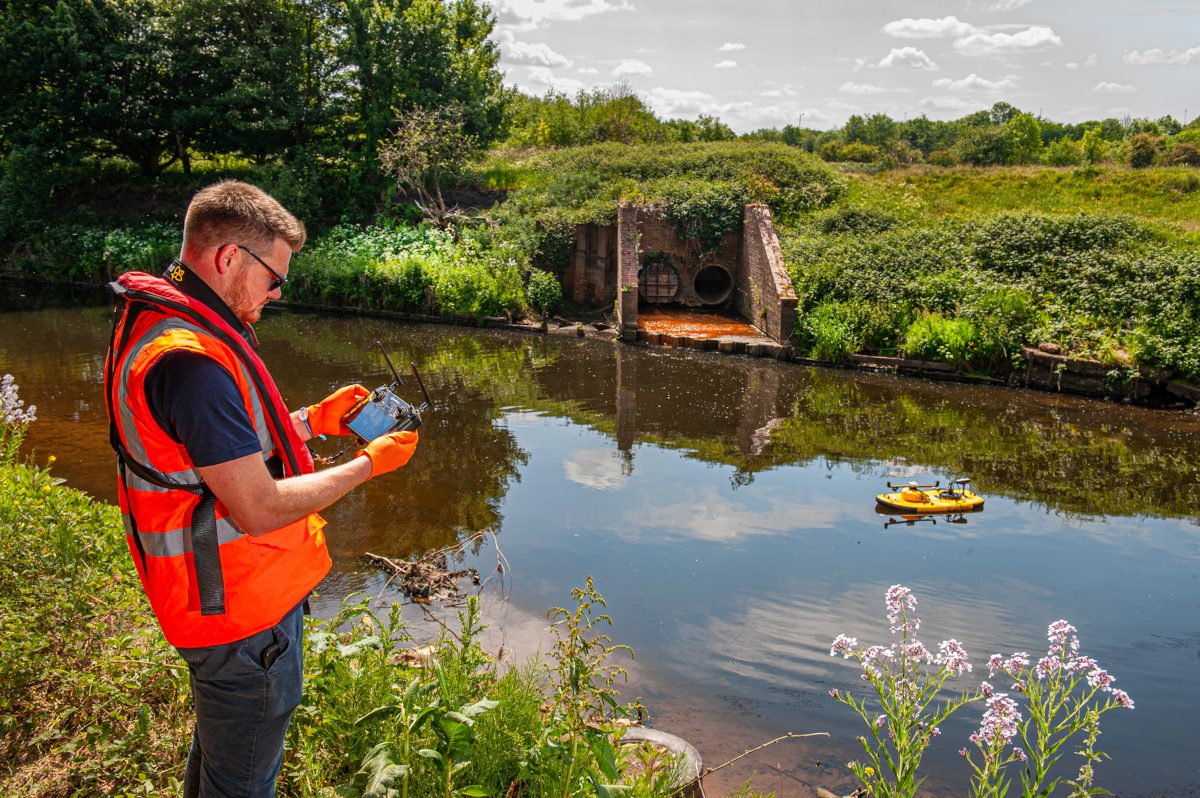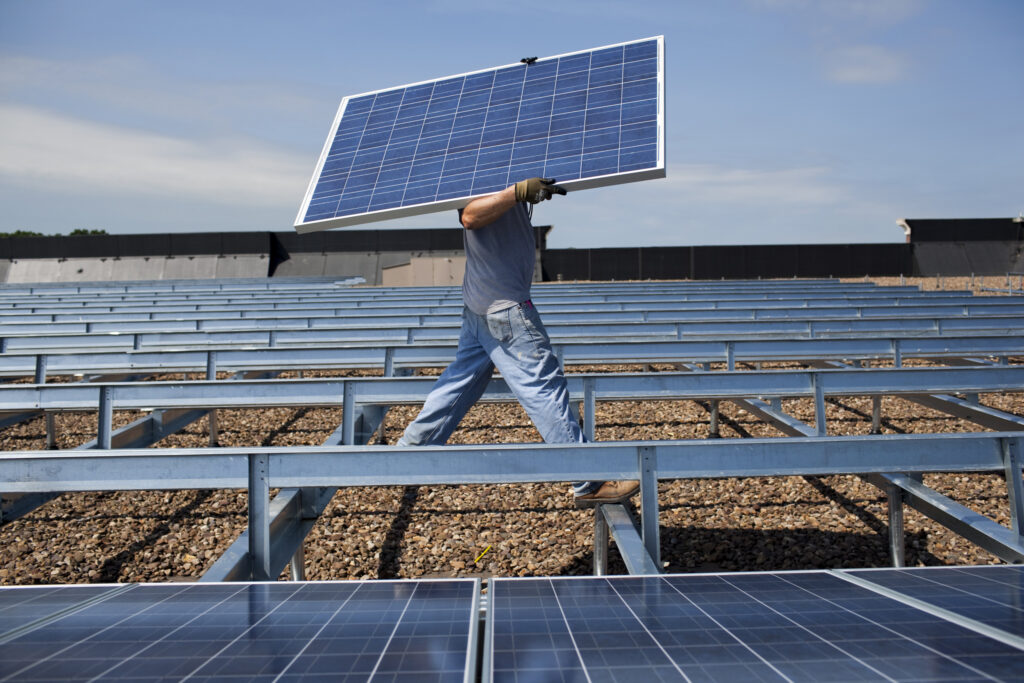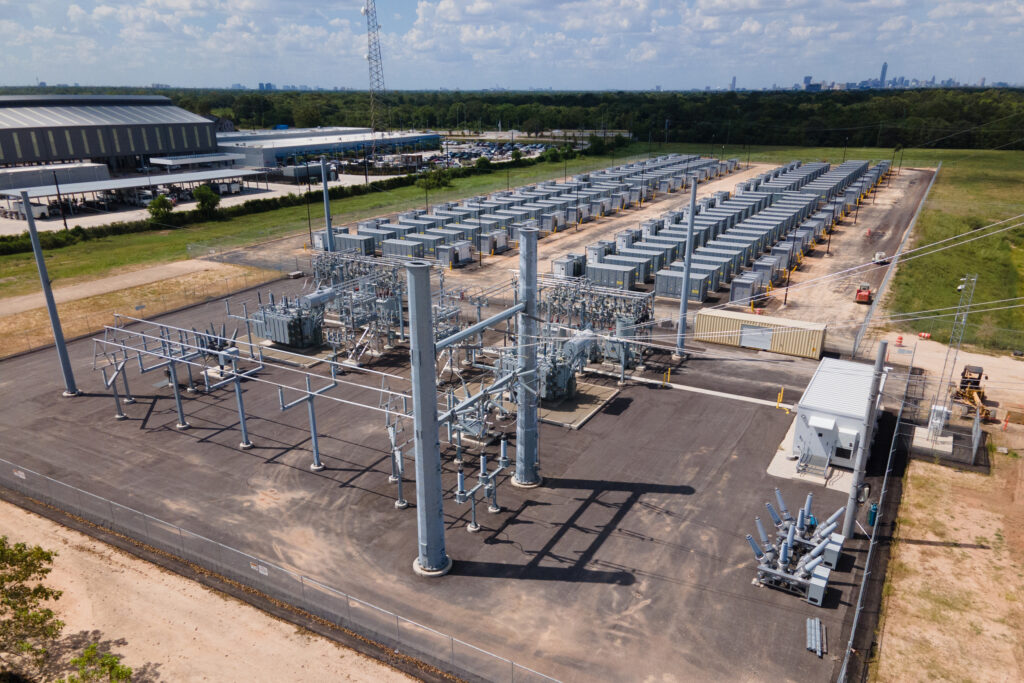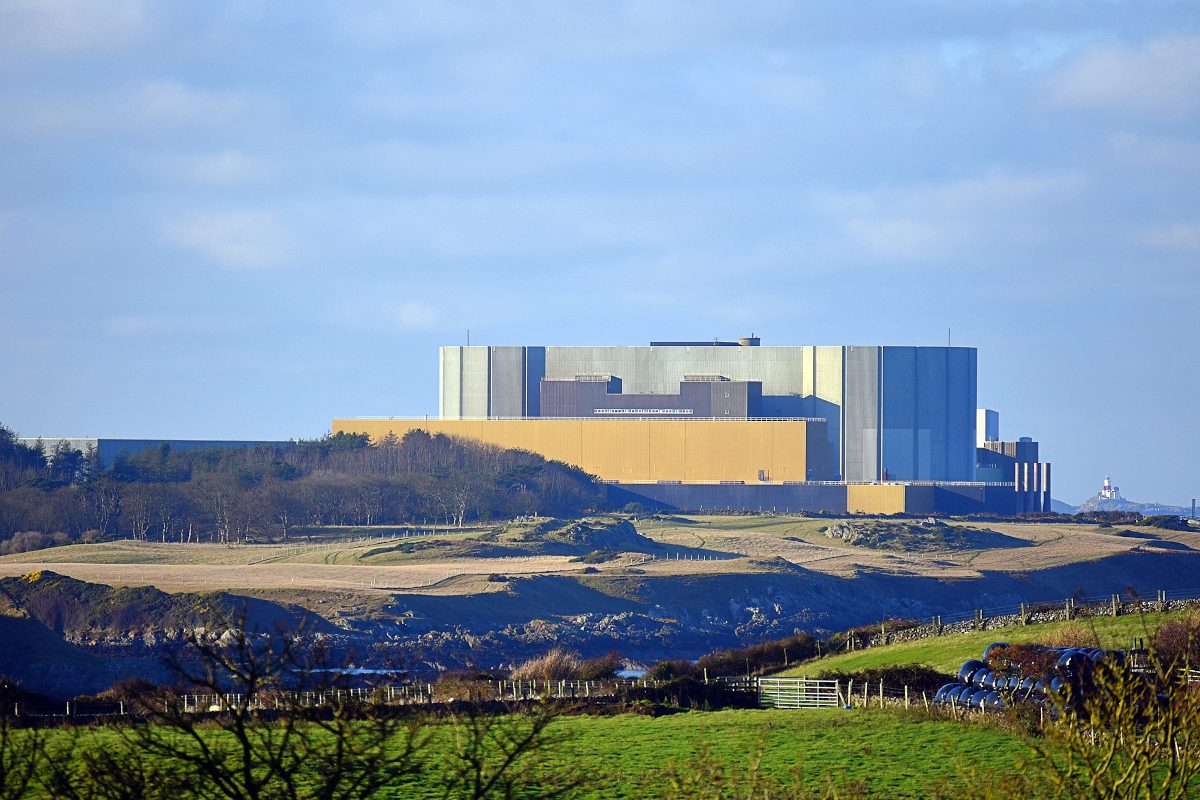Coal mines are not static. They move. A years-long time lapse of a strip mine would show a crater crawling across the Earth as miners gouge pits hundreds of feet deep to expose coal seams, and then haul dirt excavated from the front of the hole to fill in the back, where the mining’s finished. It’s an efficient way to begin the process of “reclamation,” which companies are required to implement to restore the disturbed land to some semblance of its pre-mining condition.
“You don’t want to have to move dirt twice,” as that would make the mining operation more expensive and the reclamation effort more difficult, said Rusty Bell, the director of Gillette College’s Office of Economic Transformation, as he drove his silver Ram pickup to tour coal mines in Wyoming’s Powder River Basin on a sunny day in May. A geological formation stretching from Campbell County across the state’s northeast corner into Montana, the basin is the nation’s largest producer of coal. All but four of its 16 coal mining operations are in Wyoming, many of them within 20 miles of Gillette.
Riding shotgun was Justin Loyka, an energy program director with the Nature Conservancy’s Wyoming chapter. Together, the two are trying to solve a problem the county has been staring down for over a decade: What will happen to Campbell County’s coal mines in a clean energy future? The solution, they believe, could be found in the answer to another question. Regardless of how quickly and cost effectively the mines are filled in, questions of what to do with the land once it’s reclaimed often linger. Could solar farms built on those filled craters help fill the economic void left by the area’s declining coal industry, and fulfill the aspirations of county leaders and residents who want to see it remain a home to industry?
We’re hiring!
Please take a look at the new openings in our newsroom.
See jobs
Gillette, a town of about 33,000 residents, sits in the heart of Campbell County, and has been the area’s biggest beneficiary from coal mining. When the industry came to town in the 1970s and boomed two decades later, Campbell County and Gillette soared with it. But while the region is home to some of the country’s last coal mines, its fate, like so many of Wyoming’s boom towns and cities, has been dependent on the financial success and largess of extractive industries. After the fracking boom of the early 2000s and U.S. efforts to transition its energy grids away from fossil fuels to renewable energy, the coal industry has been on a precipitous decline. The country has not opened a new coal-fired power plant since 2020, and this May, the Bureau of Land Management made federal lands in the Powder River Basin unavailable for future coal mining leases. Many believe it is only a matter of time before coal electricity goes extinct.
Politicians in Wyoming, and several of its communities, many of whom have come to rely heavily on the taxes oil, gas and coal companies pay into state coffers, view the clean energy transition as a threat to the way the state is used to providing jobs and public services. But unlike other parts of the Cowboy State that have gone belly up after the deluge of fossil fuel tax revenue suddenly dried up, Gillette’s way of life has not diminished in tandem with the demand for coal. As Bell put it, the county is “diverse in minerals.” It still draws a substantial amount of its tax revenue from oil and gas severance taxes, which, along with the now declining tax revenue from coal, have helped pay for Gillette’s spacious recreation facilities and state of the art industrial training programs. Both Gillette’s and Campbell County’s median household income are north of $90,000, about 30 percent higher than the state average, and the area’s population has remained stable during the last decade, according to U.S. Census Bureau estimates, making Gillette the exceedingly rare coal community that is not hemorrhaging its population.
Nevertheless, Bell, Loyka and other community leaders see the writing on the wall for Campbell County’s fossil fuel economy, particularly as it is driven by coal. Clean energy is “where the market is,” said Bell. “I’m not picking and choosing. I’m not deciding this or that. The market’s actually deciding that. I’m just trying to help that pathway.”
In coal country, it isn’t always so easy to see a pathway to renewable energy, yet Bell and Loyka speak enthusiastically about their plan: building solar farms on reclaimed mine lands to jump-start Gillette’s economy of the future. As coal companies begin to exit the basin, or look for other ways to profit from their land, there will be a vacuum both men hope other large industries can fill. Ideally, some of the area’s coal companies would lease a few thousand acres of reclaimed mine land to a renewable energy developer that could build a utility-scale solar farm there. The coal company would get a stable source of revenue from a booming industry, and the solar company would get to build on a site already designated for use by heavy industry and already surrounded by transmission lines, rail infrastructure and power stations in an area with fewer critical habitats for plants and wildlife in need of protection than other parts of the West. Campbell County and Gillette would get a large source of clean energy they could use to lure other industries to the region and diversify their economy.

Despite the idea’s elegance, the success of such proposals in other parts of the country and federal funding for clean energy projects running at an all-time high, Bell and Loyka’s progress has been anything but linear. Last year, the county was denied a Department of Energy grant for clean energy projects on former mine lands. So many mines have multi-year agreements with utilities that it is difficult to find room on the region’s grid for new utility-scale development, Bell and Loyka said. In the absence of federal funding, they’ve gotten some traction playing matchmaker between companies in the private sector, but those efforts have not yielded as many developments as they had hoped.
The stakes of their experiment extend beyond the county’s borders. The region appears willing to move on from the coal industry—at least as a fuel for generating electricity. If it can do that, it could show Wyoming that there is life beyond the fossil fuel economy, and that renewable energy is key to building it. It’s a big gamble, but the alternative—clinging to a collapsing fossil fuel industry while tomorrow’s energy opportunities pass Campbell County by—would be even worse, the men say.
A transition is coming, Bell said. “We can’t be lethargic in that effort.”
Solar as Power and Bait
Wyoming has been the nation’s leading producer of coal since 1986. Much like today’s transition to clean energy, Wyoming’s rise to the top of the country’s heap of coal producers was the result of market changes spurred by new federal policies aimed at addressing environmental and health concerns.
In 1990, Congress amended the Clean Air Act to limit the amount of sulfur emitted by the nation’s power plants. Coal from Appalachia, long the nation’s primary source of fuel, was dense with the element, but by geological happenstance, the coal buried in the Powder River Basin was not—and it also produced lower concentrations of hazardous particulate matter when it was burned. This made it a cleaner fuel, and less than two decades after the Clean Air Act’s updated sulfur rules were implemented, companies coveting Wyoming coal drove Campbell County’s mining boom to its peak.
The coal lands that were uniquely advantageous for generating electricity in the late 20th century are uniquely suited to solar development today.
“There’s huge post-mining landscapes in the American West and across the country, and there are huge areas that we’re trying to protect,” Loyka said. Usually, those two interests are pretty much mutually exclusive, he said, “but, not always—especially, actually, in Wyoming.”
As part of a national campaign to get more renewable energy developed on reclaimed mines and brownfields—lands that previously had heavy industrial use—the Nature Conservancy published a map marking overlaps between such areas and conservable landscapes. Their map, which drew on data from the Environmental Protection Agency, United States Geological Service and the National Oceanic and Atmospheric Administration as well as several state agencies, showed most of Wyoming’s industrial sites are embedded in a kaleidoscope of migration corridors, ungulate ranges, sage grouse habitat and areas of environmental concern that require more agonizing trade offs between the proliferation of clean energy and conservation. The lone bare spot on the map, where new industrial development would overlap less with conservation and rewilding efforts, sat squarely in Campbell County.


“There’s going to be a large amount of renewables built out across the rest of the nation—the world—and we want to see that happen because we are in favor of decarbonization,” Loyka said. “But we want to see it happen in a way that doesn’t heavily impact ecosystems and conservation resources and wildlife.”
When Loyka first moved to Wyoming in 2009, he settled in Gillette, then moved to Lander. His familiarity with the area’s culture, economics and energy landscape helped lead him to Bell in 2022, who had recently been awarded a federal grant to help draw new business to the area’s coal mines.
The two are an easy pairing. Loyka’s fast speech is permeated with enthusiasm for intersections between conservation and energy. He spent years employed as a civil engineer, and once worked at Peabody Energy, which owns mine land near Gillette that could one day house solar panels. Bell, soft spoken with dark hair and a broad smile, owns several businesses in Gillette, his hometown. He fought wildfires in the Dakotas and Oregon after he graduated college, and is adamant that any solar development on the area’s mines skirt those in national grasslands. As they drove through Gillette’s mines, they would occasionally point out mule deer or pronghorn grazing on reclaimed mine land, surrounded by gentle rolling hills of grass. At one stop, the pair spotted pelicans near a man-made pond.
“A lot of these coal mining companies, the big ones especially, their reclamation is, you know, quite well done,” Loyka said. Even though the land has been mined, its condition has recovered enough that animals have returned to graze, and its undulations are not so severe that solar panels could not one day cover them, as well.


Bell estimates there are about a quarter million acres of mine land near Gillette that could one day be used by other industries. Solar development would only need to occupy a fraction of that space to provide enough energy for other companies interested in locating on the former mine lands. “I don’t think that you’ll have 250,000 acres of solar,” he said, “but I think that can be a piece, there’s no doubt about that.”
Bell turned left and started driving southeast along Bishop Road, which had been moved several times to accommodate mining operations. As they approached the tour’s first mine, they spoke about how solar development could be the domino industry that attracts new businesses to Gillette.
“Solar is a good economic investment” for the area, Loyka said. “It makes landowners money, and it’s also an enabler for a lot of the new economic development that you have coming to these areas. If you’re talking about data centers, manufacturing or carbon removal—which is another thing that this area has all of the pieces for—you’re going to want carbon-free electrons to enable those things. If you’re coming here with a data center plan, or a manufacturing plant or you want to do carbon removal, you’ve got a short list of places. And, if one of them doesn’t have a path to getting you carbon-free electrons for five years, they’re just getting thrown out. Whereas, if you’ve got at least a path to it where you can tell them, ‘yeah, you can get carbon-free electrons here, nearby,’ that will make you more attractive to these new economic investments.”
Bell shares this opinion—to a point. Solar “has to be part of” whatever comes next for Gillette, he said. But he isn’t in a rush to usher the fossil fuel industry out of town. “I’d be crazy if I told you I wanted everything to go renewable living in Campbell County,” he said.
Still, given the market for solar, Bell thinks the county could lure a manufacturing company, data center, large battery facility or even a cryptocurrency company, befitting Gillette’s mining history, by providing large volumes of clean energy. Any one of these industries could help the area replace declining jobs and revenue from the coal industry, but Bell’s dream scenario is for a company that manufactures carbon products, things like cement or carbon fibers, to come to the area.
“What that does is keep your mining industry viable and it adds manufacturing jobs on top of that,” he said. “I mean, that makes the most sense, right? And I think at that point you can back all that up with renewables.”
At times, the free-flowing conversation between a conservationist and the de facto business matchmaker in the heart of coal country made an energy transition where people, landscapes and industry all win feel not so far out of reach. But the future Bell and Loyka envision for the area—if it ever arrives—still faces many challenges that the pair can’t easily sidestep.
‘A Chicken and the Egg Issue’
Bell and Loyka pulled over near the industrial infrastructure of Belle Ayre mine, a sprawling pit operated by Prairie Eagle Mining, and began pointing out all the reusable features: large warehouses, railroad tracks, water, industrial equipment and electrical infrastructure. That last asset, which could provide a solar company easy access to the grid, was key, they said.
But, the abundance of electrical infrastructure in the area also presents challenges—finding space on the grid in Campbell County has proven difficult. The six coal-fired power plants within 11 miles of Gillette leave little capacity for other sources on the area’s transmission lines. “The big challenge right now that we’re facing is a path to interconnection,” Loyka said.


And even if there were space on the grid tomorrow, there needs to be a place for the energy to go.
“We need a large energy consumer to come here,” Bell said.
A solar developer might be less inclined to build at utility-scale—any project that generates over 50 megawatts of power—without a clear sense of where they could sell the energy. In a Catch-22 twist, Bell continued, a large power consumer like a data center may also be hesitant to come to the area if abundant clean energy weren’t already in the works. “It’s a bit of a chicken and the egg issue, which is a pretty standard problem to have in a lot of different spaces in business,” he said.
Adding another complication is the availability, or lack, of federal funding. In March, the Biden administration announced it had awarded half a billion in funds from the Bipartisan Infrastructure Law to five projects that would “accelerate clean energy deployment on current and former mine land.” While the five states across the country awarded grants were former coal hotbeds, including Kentucky and West Virginia, Wyoming did not make the cut.
In 2023, The Nature Conservancy’s Wyoming chapter submitted a concept letter to the Department of Energy (DOE) ahead of their intended application for those funds. They proposed partnering with PacifiCorp, the state’s largest utility, and the University of Wyoming to build a 200-400 megawatt solar panel and battery storage facility on one of Eagle Specialty Minerals’ unreclaimed mines near Gillette. The site had access to transmission lines and substations, and other sites nearby that could be suitable for future development and could accommodate hydrogen fuel production or carbon capture facilities in the future, they said. Money from the grant could also help adjust Eagle Specialty Minerals’ reclamation plan to accommodate potential solar development. Gillette, they noted, “has long been a boom-and-bust town that relies heavily on the coal, oil and gas industries for the bulk of its employment and tax revenue. With thermal coal in long-term decline, the city needs new opportunities,” as the number of residents employed by the fossil fuel industry “has declined dramatically.”
The DOE, which received 98 such proposals, responded to the one from Gillette with a letter of discouragement. “That was a little frustrating,” Loyka said. The Nature Conservancy ultimately decided not to apply for the grant.


Bell believes that the region’s relatively stable quality of life may be working against it when it comes to finding federal funding. “When you don’t look like you’re struggling, it’s a little bit harder to get money,” he said.
Gillette is experiencing a housing shortage, he said, and with mineral revenue from oil and gas drilling projected to remain solid in the coming years, the area has been able to stave off a dramatic bust of its fossil fuel economy, despite the decline of coal.
Without federal money, it’s been difficult to get two private companies aligned on a solar project, in part because developing on reclaimed mine lands entails unusual uncertainties. Any solar company coming to the Powder River Basin would need to assess soil stability “because the whole area has been upset,” Loyka said. “Your panels could, like, move around or fall over potentially after five years or however long.” Federal funds could help ameliorate those risks, he added, but they’re not a deal breaker or a deal maker.
That’s part of the reason two are still optimistic that they can get some traction for utility-scale solar development in the region relatively quickly. When they stopped at Coal Creek mine, part of which is available to lease and has already been rezoned for heavy industrial use, Bell mentioned that one of the companies looking into acquiring the land had told him they were open to developing a solar project on some of it. State or federal funding might help expedite the process, but Bell and Loyka’s vision will still depend on private sector matchmaking.
“It’s tough, and it’s not anybody’s fault that it’s tough,” Loyka said. “Energy is a difficult subject.”
The Best Gillette Can Get
As the sun reached its apex, Bell and Loyka headed back north towards Gillette, which Bell has toured with different developers between visits to the mines as part of his efforts to attract new business.
While Gillette was riding the coal mining high of the 1990s, it put its tax revenue from the industry to use developing, among other things, public amenities. “Mining is in your DNA if you’re from around here,” said Jim Ford, a Campbell County commissioner with a thick salt-pepper beard above a solid, compact frame. He was a classmate of Bell’s in Gillette in the late 1980s and early 1990s. Today, as current and former elected officials, the two have helped the county spend the tax revenue it still gets from industry.
In 2010, Gillette opened a 190,000-square-foot rec center boasting three basketball courts, a climbing wall (where Loyka, an avid climber, first learned the ropes), a six-lane indoor track complete with jumping pits, indoor tennis courts, a pool, four racquetball courts, free weights and exercise equipment. Now, before fossil fuel tax revenues dry up, the town is constructing a $47 million dollar aquatics center, Bell said. Near the rec center is the Gillette College industrial training facility. Students there can don virtual reality headsets in large classrooms to practice parking tractor trailers as they train to become truckers. Later, they could walk down to the diesel training facility and work on an actual semi’s engine. Visiting heavy industry executives have raved about the equipment students get to train with, Bell said.
In the rec center, Bell and Loyka came upon an older man sitting on a bench with a cane resting on the seat next to him who asked them what they thought of the facility. “It’s pretty nice, huh?” he said. “Pardon my French, but this just shows that we didn’t piss away all the oil and coal money.”


Eventually, the energy transition came up. “That’s a sad deal,” he said. “We’re gonna need that coal to generate electricity. They keep hiding, [saying] we got enough other alternatives.”
“You don’t think so?” Loyka asked.
“No way in hell they do,” the man responded, adding that he worked in two of Gillette’s coal mines when he was younger.
His reading of coal, oil and gas tax revenue had been spot on, Bell and Loyka noted on their way out of the rec center, but that type of pushback, while understandably common among Gillette’s citizens, is mostly misguided. “The only thing he doesn’t understand is new technology,” Loyka said.
And, the town is still using oil and gas revenue to build the aquatics center, Bell pointed out. “But for how much longer?” Loyka asked. “That’s the question.”
Bell had acknowledged that oil and gas revenue could dry up within his lifetime. “That would make for an interesting landscape in terms of balancing budgets.”
Part of the reason not everyone in Campbell County is thrilled by the clean energy transition may have to do with misconceptions about what has brought about coal’s precipitous decline. “Those that are oppositional to wind and solar because they believe it hurts coal—they don’t have it right,” Ford said. “It’s been natural gas that has taken market share from coal.”
Shifting the economy of a county so intertwined with coal production in one of the nation’s reddest states means “the stakes are really high,” said Shannon Anderson, a staff attorney with Powder River Basin Resource Council, a conservation organization. Jobs, as well as entire communities’ way of life, are at stake. After the BLM announced its decision to end future leases for coal mining on federal land in the Powder River Basin, a group of county residents met with Campbell County commissioners to protest the agency’s decision. No members of the coal industry joined them, according to reports from Wyofile.
Fighting the clean energy transition isn’t the right solution to the county’s economic troubles, Anderson said.
“It’s like a 12-step program,” Anderson explained. “We need to admit there’s a problem, and a lot of folks there don’t think there’s a problem.”
Bell, Ford and other energy leaders in the county all said residents were largely on board with attracting new industries to the area, but the companies they like to see may still reflect Wyoming’s preferred outcome for the energy transition: extractive industries’ survival, and an ambivalence toward wind and solar.
Bell and Ford both said they are largely agnostic about who could develop on the area’s mining lands, so long as they bring jobs and use a lot of energy. That neutrality leaves the door open to companies that don’t fit neatly into a clean energy economy.
One company Bell and Loyka mentioned wants to use solar energy to power collisions of CO2 and hydrogen molecules to make methane, the primary component of natural gas. Because this process would use CO2 captured from the atmosphere, its backers say that the project should be considered carbon neutral, despite the emissions from combusting the gas. “Natural gas out of thin air,” Bell said, snapping his fingers.
Small modular atomic reactors, which produce emissions-free energy from nuclear fission, have been floated as suitable for the area, too, but many researchers believe their climate benefit is overstated once the mining, refining and transportation of the fuel they use, and construction of the facilities is considered. These smaller reactors are proving notoriously difficult and expensive to build—no company has constructed one in the U.S.—and scientists have raised questions about whether the volume and toxicity of the waste they generate will be even harder to dispose of than that from existing nuclear power plants. U.S. officials have yet to agree on a location and method for storing nuclear waste long term.
“It’s like a 12-step program. We need to admit there’s a problem, and a lot of folks there don’t think there’s a problem.”
Anderson said she’s heard mention of waste-to-energy facilities taking over some of the mining land near Gillette, too. “For renewable energy, we’re generally in favor,” she said. “But beyond that, you know, we’ll look at proposals kind of on a case by case basis.”
Bell was also optimistic that carbon capture technologies could keep thermal coal viable. “That’s going to happen,” he said. “To say we can’t use coal in a thermal way and not capture carbon … I wouldn’t bet against technology on that.”
While the BLM’s ban on future coal mining on federal land in the area makes this possibility seem less likely, it is unclear how the new rules would affect leases for companies using coal to make carbon-based products like cement and carbon fibers instead of burning it as fuel. Later this month, Gov. Mark Gordon is scheduled to host a town hall in Gillette to discuss, among other topics, “federal overreach” regarding the area’s energy economy.
Breaking the Boom-Bust Cycle
Late afternoon ushered in darker clouds that seemed to swell as they moved towards Gillette. Bell and Loyka were driving north down a terracotta dirt road to the former Fort Union mine that is now occupied by new projects. Atlas Carbon uses coal to make carbon for air or water filters. Its neighbor is the “Wyoming Innovation Center,” a carbon products research facility, where the University of Wyoming has a project to turn coal into bricks, Bell said. A wind turbine blade recycling company is also leasing space in the facility for research, he added.


The climate benefits from this revamped industrial park remain dubious without clean energy to power its operations, and Bell and others view the area a work in progress.
“I hesitate to say thriving because it’s not what I want it to be,” Ford, the county commissioner, said of the Fort Union site. “But it is an industrial park that now has three owners and two long term lease tenants doing things that are entirely disconnected from the traditional use of coal as a fuel for power generation. So it’s exciting.”
This story is funded by readers like you.
Our nonprofit newsroom provides award-winning climate coverage free of charge and advertising. We rely on donations from readers like you to keep going. Please donate now to support our work.
Donate Now
Rain began pattering Bell’s truck as he and Loyka made their way back to it at the end of the tour. The two parted ways in the parking lot of one of Bell’s businesses, a gym, and Loyka promised to send Bell data he believes shows there might be room right now for a utility scale power plant’s worth of energy on Gillette’s transmission lines.
In a way, what Bell and Loyka are trying to accomplish is not so different from the coal mining process. Gillette has carved for itself a vast and profitable extractive industry, but the resource, in its current incarnation, is obsolete. Like a mine crawling across the landscape in search of new assets, Bell and Loyka are trying to drag Gillette and its economy into a new, more gainful direction. Earlier that day, Bell had spoken of being haunted by stories of old Wyoming boom towns that went belly up when their industries died, most infamously Jeffrey City. In the late 1970s and early 1980s, Jeffrey’s residents, almost all of whom lost their jobs when the uranium market collapsed, moved away so rapidly that Wyomingites still murmur about how the town’s newly finished school was never put to use. Unused chalk, textbooks and desks sat neatly in the building for years they say. Fewer than 50 people live in Jeffrey now, according to 2020 census data.
“We have to diversify, and we have to be open for business for other things, because that’s where the market’s going—that’s where the investment is,” Bell said. “If we don’t adapt, then we get what we get.”







